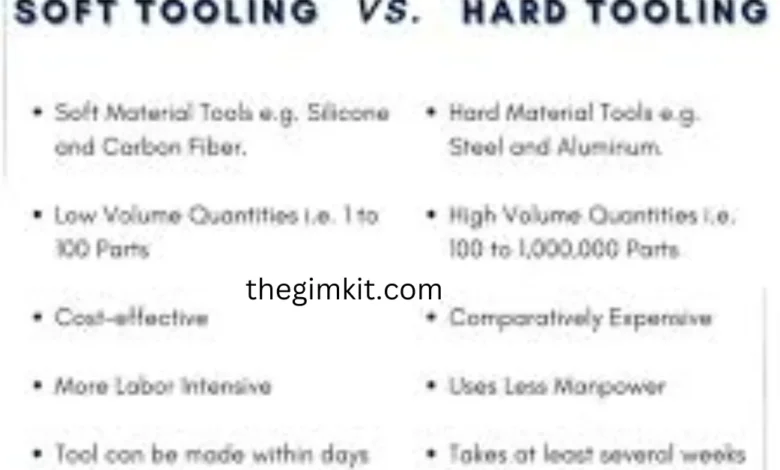Soft Tooling vs Hard Tooling: Understanding the Differences and Benefits

Introduction to Tooling
Tooling is the unsung hero of manufacturing, quietly shaping the products we use each day. In the world of tooling, there are predominant gamers: soft tooling vs hard tooling. Each brings its strengths to the desk, catering to exceptional wishes inside the production technique. So, buckle up as we dive into the dynamic duo of tender versus tough tooling, unravel their mysteries, and unveil which one might simply be your production powerhouse!
What is Soft Tooling?
Soft tooling refers to the usage of bendy substances like silicone or urethane to create molds for production methods. Unlike difficult tooling, which uses inflexible materials like steel, tender tooling gives versatility and fee effectiveness in generating prototypes and occasional-quantity parts.
These molds can be easily modified or repaired, allowing for short iterations at some stage in product development. Soft tooling is ideal for initiatives with shorter manufacturing runs or wherein design adjustments are expected. It gives a quicker turnaround time as compared to hard tooling, making it a favored preference for rapid prototyping.
Additionally, gentle tooling reduces lead instances and costs associated with conventional machining techniques. Its flexibility permits manufacturers to check new designs without sizeable investments in permanent gear upfront. This adaptability makes gentle tooling an attractive alternative for industries trying to streamline their manufacturing approaches effectively.
Advantages and Disadvantages of Soft Tooling
Soft tooling gives flexibility and value-effectiveness in the production method. One key benefit is its potential to speedy produce prototypes or small production runs, bearing in mind rapid iterations and testing of designs. This can extensively reduce time-to-market for brand-spanking new products.
Additionally, gentle tooling substances like silicone or urethane are simpler to the system as compared to metals utilized in tough tooling, saving time and money throughout the fabrication technique. The softer materials additionally assist in preventing damage to delicate elements during molding.
However, one drawback of tender tooling is its constrained lifespan as compared to difficult tooling. soft tooling vs hard tooling molds may additionally wear out quicker due to their pliable nature when exposed to excessive volumes of manufacturing cycles. In this manner they will need a common substitute, raising usual costs in the long run.
Despite this issue, soft tooling remains a treasured alternative for projects that require rapid turnaround instances and low preliminary investment.
What is Hard Tooling?
Hard tooling refers to the manufacturing technique of the usage of rigid substances like metallic or aluminum to create molds and dies for mass manufacturing. These equipment are durable and long-lasting, capable of producing high volumes of elements with precision and repeatability.
Unlike soft tooling, tough tooling is ideal for projects that require high accuracy and consistency in product dimensions. The strong nature of tough tooling permits for minimum wear and tear over the years, making it a cost-powerful solution for huge-scale manufacturing runs.
However, the initial setup costs for tough tooling can be better than tender tooling due to the substances used and the machining techniques involved. Additionally, any design modifications or adjustments may be more expensive and time-consuming with hard tooling compared to its softer counterpart.
When efficiency, sturdiness, and particular replication are paramount in manufacturing processes, tough tooling is a dependable solution for accomplishing consistent high-quality outputs.
Advantages and Disadvantages of Hard Tooling
When it involves tough tooling, one of the key blessings is its durability. Hard tooling is usually made from substances like steel, which can resist high manufacturing volumes and repetitive use without extensive wear and tear.
Additionally, hard tooling offers precision and accuracy in production approaches. The inflexible nature of difficult equipment permits for consistent shaping and forming of parts to tight tolerances, ensuring high-quality output.
On the drawback, the preliminary investment required for tough tooling can be quite full-size. Manufacturers need to remember the value implications before choosing difficult gear as they’re greater high priced than tender tooling options.
Another drawback of tough tooling is its longer lead instances for fabrication. Since hard gear is generally custom-made and machined from sturdy substances, it takes extra time to supply them as compared to softer alternatives.
When to Use Each Type of Tooling?
When finding between soft tooling vs hard tooling, information while applying every kind is critical for the fulfillment of your manufacturing assignment. Soft tooling is right for fast prototyping or low-quantity manufacturing runs wherein flexibility and price effectiveness are key. Its potential to be quickly changed makes it best for trying out one-of-a-kind designs earlier than committing to mass production.
On the opposite hand, tough tooling shines in high-volume manufacturing eventualities wherein sturdiness and precision are paramount. The in-advance costs may be better, but the lengthy-term benefits in phrases of efficiency and consistency make it tough to tool smart funding for massive-scale production operations.
Consider the use of soft tooling while you need agility and quick iterations for the duration of the layout segment while choosing tough tooling whilst aiming for consistent best output at scale. Tailoring your desire based totally on those elements will help you acquire the most advantageous consequences in your production approaches.
Conclusion:
In the producing enterprise, deciding between soft tooling vs hard tooling can considerably impact manufacturing performance and costs. Soft tooling offers flexibility and price-effectiveness for prototyping and occasional extent production runs. On the other hand, difficult tooling affords durability and high precision for large-scale mass production.
Understanding the differences and advantages of tender as opposed to hard tooling is critical for making knowledgeable decisions that align with your venture requirements. Whether you opt for gentle or tough tooling relies upon factors including finances, the extent of elements needed, lead instances, material houses, and layout complexity.
FAQs:
1. What is soft tooling?
Soft tooling refers to the use of brief or without-difficulty adjustable molds, dies, or gear usually made from substances like silicone, urethane, or aluminum. These molds are suitable for quick production runs or prototyping functions.
2. What is tough tooling?
Hard tooling involves the introduction of everlasting molds, dies, or tools generally crafted from materials like metal or other long-lasting alloys. These gear are designed for long-term use and are capable of withstanding high-extent manufacturing.
3. What are the advantages of smooth tooling?
Flexibility: Soft tooling allows for short adjustments and modifications, making it best for rapid prototyping or small-scale manufacturing.
Cost-effectiveness: Initial setup charges for tender tooling are often decreased compared to tough tooling, making it extra low-cost for quick production runs.
Faster turnaround: Since gentle tooling may be fabricated and modified enormously quickly, it permits quicker product improvement cycles.
4. What are the negative aspects of smooth tooling?
Limited sturdiness: Soft tooling substances might also put on out quicker, main to shorter tool lifespans as compared to tough tooling.
Lower precision: Soft tooling won’t reap the equal stage of precision as difficult tooling, mainly for intricate designs or tight tolerances.
Unsuitability for excessive volumes: Soft tooling is normally not suitable for high-extent manufacturing due to its confined durability and slower production speeds.
5. What are the blessings of hard tooling?
Durability: Hard tooling is built to resist high-volume manufacturing over extended durations, offering long-term reliability and consistency.
High precision: Hard tooling can gain very tight tolerances and problematic designs, making sure superior products are first-class.
Cost-effectiveness for huge volumes: While the preliminary setup fees may be higher, difficult tooling will become more value-powerful over time for large-scale manufacturing runs.
6. What are the hazards of difficult tooling?
Longer setup instances: Fabricating tough tooling molds or dies normally takes longer in comparison to gentle tooling, resulting in longer lead times for initial manufacturing.
Limited flexibility: Once created, tough tooling is hard and highly-priced to adjust, making it less suitable for fast design iterations or product adjustments.
Higher preliminary charges: Hard tooling regularly calls for substantial advance investment in materials and manufacturing approaches, which can be prohibitive for small-scale manufacturing or prototyping.
7. When do need to I use smooth tooling?
Soft tooling is high-quality and suitable for:
Prototyping new products or designs.
Low-volume manufacturing runs.
Products with frequent layout changes or iterations.
Quick turnaround tasks where pace is prioritized over sturdiness.
8. When must I use tough tooling?
Hard tooling is usually recommended for:
High-quantity production runs.
Products requiring specific tolerances or complicated geometries.
Long-term production tasks with solid designs.
Situations wherein durability and reliability are paramount, even at better initial costs.
9. Can soft and tough tooling be used collectively?
Yes, hybrid techniques combining tender and tough tooling techniques are common in production. For example, gentle tooling can be used to start with for prototyping and early manufacturing ranges, with a transition to hard tooling for huge-scale production as soon as the layout is finalized.
10. How do I decide between tender and hard tooling for my assignment?
Consider elements that include manufacturing quantity, price range constraints, design complexity, required precision, and timeline whilst selecting soft and difficult tooling. Evaluate the exchange-offs between flexibility, value, and durability to determine the most appropriate approach for your particular needs. Consulting with skilled production specialists or engineers can also provide valuable insights and guidance.
Read More: Power of the Flanking Strike Macro Sod: A Comprehensive Guide




